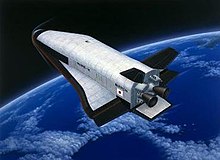
An expendable launch system is a launch vehicle that can be launched only once, after which its components are either destroyed during reentry or discarded in space. ELVs typically consist of several rocket stages that are discarded sequentially as their fuel is exhausted and the vehicle gains altitude and speed. As of 2024, less and less satellites and human spacecraft are launched on ELVs in favor of reusable launch vehicles. However, there are many instances where a ELV may still have a compelling use case over a reusable vehicle. ELVs are simpler in design than reusable launch systems and therefore may have a lower production cost. Furthermore, an ELV can use its entire fuel supply to accelerate its payload, offering greater payloads. ELVs are proven technology in widespread use for many decades.
Human spaceflight programs have been conducted, started, or planned by multiple countries and companies. Until the 21st century, human spaceflight programs were sponsored exclusively by governments, through either the military or civilian space agencies. With the launch of the privately funded SpaceShipOne in 2004, a new category of human spaceflight programs – commercial human spaceflight – arrived. By the end of 2022, three countries and one private company (SpaceX) had successfully launched humans to Earth orbit, and two private companies had launched humans on a suborbital trajectory.

A spaceplane is a vehicle that can fly and glide like an aircraft in Earth's atmosphere and maneuver like a spacecraft in outer space. To do so, spaceplanes must incorporate features of both aircraft and spacecraft. Orbital spaceplanes tend to be more similar to conventional spacecraft, while sub-orbital spaceplanes tend to be more similar to fixed-wing aircraft. All spaceplanes to date have been rocket-powered for takeoff and climb, but have then landed as unpowered gliders.

The Lockheed Martin X-33 was a proposed uncrewed, sub-scale technology demonstrator suborbital spaceplane that was developed for a period in the 1990s. The X-33 was a technology demonstrator for the VentureStar orbital spaceplane, which was planned to be a next-generation, commercially operated reusable launch vehicle. The X-33 would flight-test a range of technologies that NASA believed it needed for single-stage-to-orbit reusable launch vehicles, such as metallic thermal protection systems, composite cryogenic fuel tanks for liquid hydrogen, the aerospike engine, autonomous (uncrewed) flight control, rapid flight turn-around times through streamlined operations, and its lifting body aerodynamics.
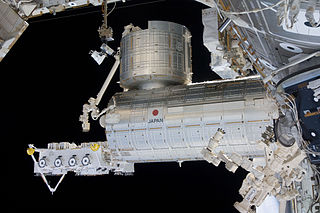
The National Space Development Agency of Japan, or NASDA, was a Japanese national space agency established on October 1, 1969 under the National Space Development Agency Law only for peaceful purposes. Based on the Space Development Program enacted by the Minister of Education, Culture, Sports, Science and Technology (MEXT), NASDA was responsible for developing satellites and launch vehicles as well as launching and tracking them.

The Japan Aerospace Exploration Agency (JAXA) is the Japanese national air and space agency. Through the merger of three previously independent organizations, JAXA was formed on 1 October 2003. JAXA is responsible for research, technology development and launch of satellites into orbit, and is involved in many more advanced missions such as asteroid exploration and possible human exploration of the Moon. Its motto is One JAXA and its corporate slogan is Explore to Realize.
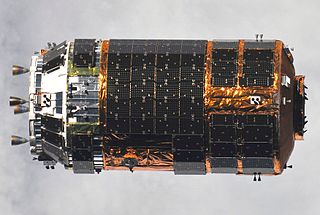
The H-II Transfer Vehicle (HTV), also called Kounotori, is an expendable, automated cargo spacecraft used to resupply the Kibō Japanese Experiment Module (JEM) and the International Space Station (ISS). The Japan Aerospace Exploration Agency (JAXA) has been working on the design since the early 1990s. The first mission, HTV-1, was originally intended to be launched in 2001. It launched at 17:01 UTC on 10 September 2009 on an H-IIB launch vehicle. The name Kounotori was chosen for the HTV by JAXA because "a white stork carries an image of conveying an important thing, therefore, it precisely expresses the HTV's mission to transport essential materials to the ISS". The HTV is very important for resupplying the ISS because after the retirement of the Space Shuttle it is the only vehicle that can transfer new 41.3 in (105 cm) wide International Standard Payload Racks (ISPRs) and dispose old ISPRs that can fit the 51 in (130 cm) wide tunnels between modules in the US Orbital Segment.

The Boeing X-37, also known as the Orbital Test Vehicle (OTV), is a reusable robotic spacecraft. It is boosted into space by a launch vehicle, then re-enters Earth's atmosphere and lands as a spaceplane. The X-37 is operated by the Department of the Air Force Rapid Capabilities Office, in collaboration with United States Space Force, for orbital spaceflight missions intended to demonstrate reusable space technologies. It is a 120-percent-scaled derivative of the earlier Boeing X-40. The X-37 began as a NASA project in 1999, before being transferred to the United States Department of Defense in 2004. Until 2019, the program was managed by Air Force Space Command.

Dream Chaser is an American reusable lifting-body spaceplane developed by Sierra Space. Originally intended as a crewed vehicle, the Dream Chaser Space System is set to be produced after the Dream Chaser Cargo System cargo variant is operational. The crewed variant is planned to carry up to seven people and cargo to and from low Earth orbit. Sierra plans to manufacture a fleet of the spaceplane.

The Orbital Space Plane (OSP) program was a NASA spaceplane concept in the early 2000s designed to support the International Space Station requirements for crew rescue, crew transport and contingency cargo transport. It was part of the Space Launch Initiative.

H-IIB (H2B) was an expendable space launch system jointly developed by the Japanese government's space agency JAXA and Mitsubishi Heavy Industries. It was used to launch the H-II Transfer Vehicle cargo spacecraft for the International Space Station. The H-IIB was a liquid-fueled rocket, with solid-fuel strap-on boosters and was launched from the Tanegashima Space Center in southern Japan. H-IIB made its first flight in 2009, and had made a total of nine flights through 2020 with no failures.

Fuji (ふじ) was a crewed spacecraft of the space capsule kind, proposed by Japan's National Space Development Agency (NASDA) Advanced mission Research center in December 2001. The Fuji design was ultimately not adopted.

Akihiko Hoshide is a Japanese engineer, JAXA astronaut, and former commander of the International Space Station. On August 30, 2012, Hoshide became the third Japanese astronaut to walk in space.
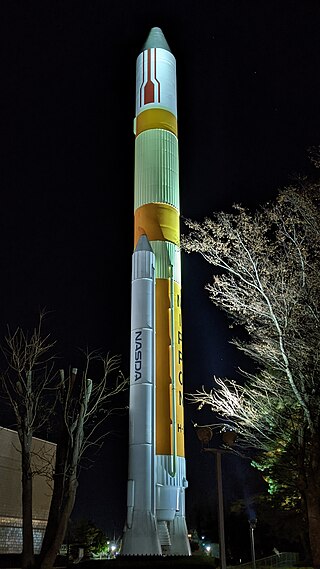
The H-II (H2) rocket was a Japanese satellite launch system, which flew seven times between 1994 and 1999, with five successes. It was developed by NASDA in order to give Japan a capability to launch larger satellites in the 1990s. It was the first two-stage liquid-fuelled rocket Japan made using only technologies developed domestically. It was superseded by the H-IIA rocket following reliability and cost issues.
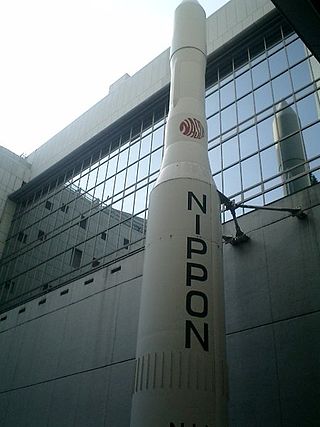
The N-I or N-1 was a derivative of the American Thor-Delta rocket, produced under license in Japan. The N stood for "Nippon" (Japan). It used a Long Tank Thor first stage, a Mitsubishi Heavy Industries-designed LE-3 engine on the second stage, and three Castor SRMs. Seven were launched between 1975 and 1982, before it was replaced by the N-II. Six of the seven launches were successful, however on the fifth flight, there was recontact between the satellite and the third stage, which caused the satellite to fail.

The Japanese space program originated in the mid-1950s as a research group led by Hideo Itokawa at the University of Tokyo. The size of the rockets produced gradually increased from under 30 cm (12 in) at the start of the project, to over 15 m (49 ft) by the mid-1960s. The aim of the original research project was to launch a man-made satellite.

A number of different spacecraft have been used to carry cargo to and from space stations.
The DARPA XS-1 was an experimental spaceplane/booster with the planned capability to deliver small satellites into orbit for the U.S. Military. It was reported to be designed to be reusable as frequently as once a day, with a stated goal of doing so for 10 days straight. The XS-1 was intended to directly replace the first stage of a multistage rocket by taking off vertically and flying to hypersonic speed and high suborbital altitude, enabling one or more expendable upper stages to separate and deploy a payload into low Earth orbit. The XS-1 would then return to Earth, where it could ostensibly be serviced fast enough to repeat the process at least once every 24 hours.
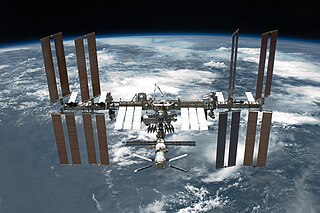
Origins of the International Space Station covers the origins of ISS. The International Space Station programme represents a combination of three national space station projects: the Russian/Soviet Mir-2, NASA's Space Station Freedom including the Japanese Kibō laboratory, and the European Columbus space stations. Canadian robotics supplement these projects.

SSC Demo-1, also known as Dream Chaser Demo-1, is the planned first flight of the Sierra Space robotic resupply spacecraft Dream Chaser to the International Space Station (ISS) under the CRS-2 contract with NASA. The demonstration mission is planned for launch in June 2024 on the second flight of the ULA Vulcan Centaur rocket.
